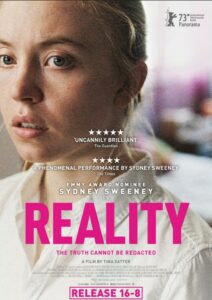
Reality by Tina Satter: the importance of the script and its correct interpretation
Reality tells the real-time story of the arrest of Reality Winner – a translator at Pluribus, an NSA subcontractor, who dreamed of becoming a Snowden-style whistleblower in the polarised America of the Trump years. The confidential document she sent to The Intercept, an online magazine, earned her a five-year prison sentence.
In France, according to a recent Senate report, more than 25% of wiretaps and judicial interceptions are carried out outside PNIJ, the famous judicial interception platform soon to be fully supervised by ANTENJ.
 Specialists in continuous QM (Quality Monitoring), i.e. listening in on conversations to improve quality or security, will find many instructive links with their profession, as will those who, in the day-to-day exercise of their duties, have to create proximity in order to reveal, sell or get people to confess. A film without murders, packed with suspense despite the fact that virtually nothing happens in it. What is true, what is false, how do we understand what is said, what we hear, what we are shown?
Specialists in continuous QM (Quality Monitoring), i.e. listening in on conversations to improve quality or security, will find many instructive links with their profession, as will those who, in the day-to-day exercise of their duties, have to create proximity in order to reveal, sell or get people to confess. A film without murders, packed with suspense despite the fact that virtually nothing happens in it. What is true, what is false, how do we understand what is said, what we hear, what we are shown?
A conceptual film, based as it is on a script that is a transcription to the letter of the exchanges that took place between Reality Winner and the FBI agents who came to arrest him, Reality presents the paradox of being an adaptation of a play, not a single word of which is original or invented. Any fabrication here consists solely of the interpretation of this text and its staging. At a time when everything we do tends to be recorded, analysed and archived, sometimes without our knowledge, the merit of Tina Satter’s film lies first and foremost in highlighting the bizarre nature of procedures that may appear harmless but are in no way so.
Reality is first and foremost a document on how FBI agents go about their work: how they grill a suspect and extract a confession from him, a suspect who at first appears harmless to the viewer, but who soon turns out to be a firearms expert. For example, unlike the main character, who doesn’t seem to mind, the viewer is surprised not to hear the Miranda warning (« you have the right to remain silent, etc. »), a warning heard a thousand times before arrests in American films. In the course of this conversation bathed in discomfort, interspersed with banalities on subjects such as dogs and body-building, a well-honed skill is expressed in which spontaneity is not normally allowed.
What is human, what is mechanical, what is robotic in these exchanges? This is the question explored by the film with a fine sense of the strange, like a variation on the Turing test. In the world of contact centres, we all know the importance of the meticulously-crafted script, the way it is performed, the difficult balance between the mechanical and the human it aims to achieve (the author of these lines has a cousin who was sacked by Teleperformance in his student days because of the liberties he took with the script, which he considered too mechanical, and because he spoke out against it to the client). All of these things are ultimately decided by conversation analysis, aided by the increasingly sophisticated tools of speech-to-text and AI. In a way, Reality is a reminder of the need for what we might call a human interpretation of the script, especially when it is presented as mechanics applied to human beings.
The story on which the film is based: on 3 June 2017, Reality Winner, a 25-year-old American woman, is interrogated at her home in Georgia by two FBI agents. She was later accused of passing on to an online media outlet, The Intercept, a document considered confidential, a reprehensible act under the Espionage Act.
Earlier in her career, in the US Air Force, Reality Winner was responsible for listening to and transcribing conversations intercepted by her employer as part of anti-terrorism operations. She was then hired by Pluribus International Corporation, an NSA contractor, for unspecified functions.
Social psychology techniques used in FBI interrogation.
Is this a room is Tina Satter’s hit Broadway play based exclusively on the transcript of the interrogation conducted by the two FBI agents on 3 June 2017. The psychological techniques used by the FBI agents to create a form of closeness with the person being questioned are fascinating, modern. « The FBI agents seek to establish a climate of trust and cooperation, by latching onto subjects of interest to the young woman, her pets, the sport she plays, the shopping she’s just done. These exchanges, which are by and large banal, are governed by the norms of the society in which we live: if someone is interested in you, the norm of reciprocity requires that you also do something in return, namely talk here ». The young woman, struggling with her emotions, is consumed by a form of inner conflict. For the FBI agents, « the challenge is to gradually sway her to the side that’s best for them ». This means reducing Reality’s sense of guilt and individual responsibility, and encouraging her to confide in them. In this way, the film echoes the famous study on the limits of obedience, coordinated by the American psychologist Stanley Milgram in the early 1960s.
« Yann Calvet, lecturer in film studies at the LASLAR laboratory.
*Excerpts from discussions held at the Café des images, Ciné Science, on Thursday 30 November with specialists from the University of Caen Normandie, including Virginie Bagneux, lecturer in social psychology at the Caen Normandie psychology laboratory.
To find out more:
Pluribus International Corporation was sold in 2019 to Metis Solutions, another American company in the same business sector.
In France, PNIJ is the judicial interception platform that was entrusted to Thalès, under astonishing conditions in 2014, contested in particular by Elektron and Foretec. More than 100 million communications are intercepted every year, and 10,000 lines are said to be permanently monitored. The contract with Thalès is not due to be renewed in 2024, with part of the activities now supervised by ANTENJ, the national agency for judicial digital investigation techniques, headed by Jean-Julien Xavier Rolai, a magistrate.
A recent report by a Senate committee of enquiry was published in November, and it is highly instructive.
The spectator experience during the session, by the two columnists.
 Seen at the MK2 Odéon (Saint-Michel side), formerly named MK2 Hautefeuille. We deplore this way of using the same name for two cinemas physically separated by a few hundred metres. This can lead to confusion that need not exist. This is a variation on the criticism levelled at the MK2 Quai de Loire and Quai de Seine, which face each other, separated by the Canal de l’Ourcq, and whose names are so easy to swap in one’s memory (Benoit Hocquet).
Seen at the MK2 Odéon (Saint-Michel side), formerly named MK2 Hautefeuille. We deplore this way of using the same name for two cinemas physically separated by a few hundred metres. This can lead to confusion that need not exist. This is a variation on the criticism levelled at the MK2 Quai de Loire and Quai de Seine, which face each other, separated by the Canal de l’Ourcq, and whose names are so easy to swap in one’s memory (Benoit Hocquet).
The film was also screened at the Astrée, an art-house cinema in Chambéry (Manuel Jacquinet). This is a city-centre venue with an outstanding programme and excellent facilities. Tickets are still sold by reception staff. At Pathé, on the other hand, in Montparnasse, the staff help you to use the ticket machines in a hall that looks like a station concourse, impersonal and vast. You pay 4 euros more than a normal ticket to get a bigger seat that can be transformed into a bed. Strange, but appreciated by customers. In the lobby, you can see the popcorn.
Benoit Hocquet and Manuel Jacquinet.
NB: In each issue of En-Contact, a journalist talks about a film he or she has seen and enjoyed, and the experience of watching it.







